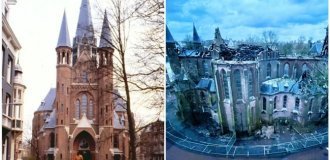The ball is an invariable attribute of any football festival. At certain stages of the development of the world industry, the shape, details, color, design of the simplest and most democratic sports equipment underwent various changes. Due to developing technologies, under the influence of public opinion and fashion, balls were purchased and parted with lacing on the side, the number of components of the playing equipment, technical characteristics, its color and patterns changed.

T-Model, Uruguay, 1930
At the first World Cup, which took place in Uruguay, the soccer ball showed how important it is for the game. The finalists of the championship, the national teams of Argentina and Uruguay, had a serious quarrel over which sports equipment the teams would use to determine the strongest. The organizers had to offer a compromise, which both teams agreed to. In the first half, the teams played with a Tiento ball, which the guests brought with them, and after the break, the Uruguayans took out their ball - T-Model. The projectile was larger and heavier than Tiento, consisted of 12 parts and massive lacing. Apparently, the dispute was not unfounded: losing 1:2 on their home turf, the Uruguay team snatched victory, scoring two goals against the Argentines. As a result, the first final match at the highest level ended with a score of 2:4 in favor of the World Cup hosts.

Federale 102, Italy, 1934
Lacing, which was an integral and forced element of footballs of that time, caused many problems for football players. Firstly, hitting the exposed skin with the side of the ball caused severe pain to the players, and secondly, this detail did not contribute to aerodynamics, adding unpredictability to the flight of the ball, which, however, sometimes played in favor of entertainment. Federale was manufactured by the Italian company ECAS specifically for the World Championship and consisted of 13 polygons closely stitched together.

Allen, France, 1938
The ball bouncing across the French lawns in the summer of 1938 got its name from the equipment company that was then the main supplier of World Cup equipment. The Allen was similar to the ball from the previous World Cup, but had more rounded panel corners and modified lacing. The last element has almost become a rudiment, and on French soil this ball became the last sports equipment with lacing. The appearance four years later of a modified game equipment marked a new era in the creation of sports equipment.

Superball Duplo T, Brazil, 1950
The 1942 and 1946 World Championships did not take place for obvious reasons. The Second World War was raging in Europe and beyond, and it was not possible to assemble teams for an international championship, even the most popular and popular game in the world. But in 1950, after more than a ten-year break, the World Cup was held brilliantly in Brazil, the homeland of the “ball wizards,” as local football players would later be called. The ball, like some of the rules of the tournament, had undergone changes: now it could be inflated using a pump and a needle through a valve. The lacing has disappeared forever, and with it the high probability of injury from contact with a football projectile.

Swiss World Champion, Switzerland, 1954
The World Cup ball, taking place in Switzerland, was produced by Kost Sport and was made of 18 panels for the first time. Its design and appearance, apart from the increased number of parts that made up the sphere of the ball, have not undergone significant changes compared to the Brazilian ball. It is worth saying that since this championship, the International Football Association (FIFA) for the first time took the choice of sports equipment seriously. Each ball was now weighed, and its size and diameter were strictly regulated by the organizer.

Top Star, Sweden, 1958
The Top Star ball was manufactured by Sydsvenska L?der-och Remfabriken and consisted of 24 panels sewn together. In addition to, again, an increased number of pieces of leather from which the ball was sewn, Swedish football equipment was presented in three colors: brown, orange and white. From now on, the participating teams received a certain number of balls at their disposal until the end of the championship in order to try the “round” in practice during training.

Crack, Chile, 1962
The Crack ball, as if befitting its “breaking” name, revolutionized the sports industry. The creator of the ball, Custodio Zamora, abandoned the use of longitudinal strips from which the sphere was sewn and opted for hexagons. The reaction to the innovation was ambiguous: the European teams ignored the ball, and the referee of the opening match ordered the “wrong” sports equipment to be replaced in the second half.

Challenge 4-Stars, England, 1966
The cheerful colors of the Challenge 4-Star ball seemed to predict a rock and roll and unpredictable tournament, in which the English, the hosts of the championship, won the cup for the first time. The football equipment, however, had several colors, although orange was preferred in matches. The Slesinger company, which produced the ball for the British World Cup, subsequently passed the baton to the next manufacturer of sports products - the German company Adidas, which produces balls for the World Cup to this day.

Telstar Durlast, Mexico, 1970
The Telstar ball was first sewn from 32 multi-colored pentagons and marked the beginning of the era of hegemony for the company of Adi Dassler and his descendants. Adidas made a two-color ball for the Mexican championship for a reason. The World Cup in Mexico was the first in history to be broadcast to the whole world using the American Telstar satellite, and the two-color sports equipment of the same name would have been difficult to see on a black and white screen if not for its contrasting colors.

Telstar Durlast, Germany, 1974
Adidas didn't bother much when preparing the official ball for the championship in Germany. By presenting a sports equipment almost identical to the Mexican Telstar Durlast, the Germans emphasized with this fact the success of the previous ball, and also indicated a trend in football fashion towards a “pentagonal” design.

Tango River Plate, Argentina, 1978
Designers worked hard on the colors of the Tango ball. Instead of black and white rectangles, the sports equipment became completely white, but 20 black triads were applied to its surface, creating the illusion of 12 circles edging the ball. This design became a classic and in the 20th century all World Cup balls had a similar design.

Tango Espa?a, Spain, 1982
As noted above, all subsequent world championship balls until 2002 were similar to each other. Only the characteristics of the game shells changed. quite a bit, drawing on triads. The Tango, made for the World Cup in Spain, was the last ball made from leather by the German giant, only now the seams were securely taped for play in wet conditions. The ball did not get wet and retained the same weight.

Azteca, Mexico, 1986
The design of the ball for the World Cup, taking place for the second time on Mexican soil, was inspired by the architecture and frescoes of the Aztecs. The triads had a pattern characteristic of the local culture, emphasizing the identity of the ball and being a tribute to the ancient people. For games in high altitude conditions, the ball was made even stronger, for which the players thanked the manufacturer more than once. The Azteca was the first ball made entirely of synthetic materials.

Etrusco Unico, Italy, 1990
The Germans once again paid tribute to the rich culture of the championship hosts. This time, instead of Aztec elements, each triad “received” three heads of Etruscan lions. According to the company, the characteristics of the ball have been improved, and the manufacturing quality has moved to a new level. Etrusco is the first ball from Adidas, the inner layer of which is made of polyurethane foam.

Questra, USA, 1994
In the design of triads already familiar to football players and ordinary fans, the creators of Questra reflected the American love for star motifs. The ball was decorated with images of celestial bodies, stars and comets. The name Questra itself comes from the phrase “the quest for the stars.” The ball really “tended for the stars” - it became “more obedient”, when hit, it flew further and at greater speed, as the participants of the 1994 World Cup themselves stated.

Tricolore, France, 1998
The Tricolore was the first multi-colored ball, with blue and red replacing the classic black. The design of the triads reflected the symbols of France and the French Football Federation - the French flag and the tail of a rooster. The inside of the ball again consisted of polyurethane foam, and the outside was a regular matrix of durable microcells filled with gas. This innovation was aimed at increasing the life of the ball.

Fevernova, Korea - Japan, 2002
The championship in eastern countries was the first World Cup in which the official ball replaced the usual triads with the image of a figure, the creation of which was inspired by Asian cultures. The updated appearance was heavily criticized - the football community was too accustomed to the triads that have invariably appeared on sports equipment since 1978. The abundance of goals scored in 2002 was partly due to Fevernova's unpredictable flight.

Teamgeist, Germany, 2006
The ball, called “Teamgeist” (“team spirit”), made another revolution in the production of sports equipment. Adidas has moved away from the classic 32-panel design for the first time in 36 years, creating a new ball using 14 outer structural panels. The manufacturer claimed that the joints between the panels were reduced by 60% compared to previous balls, which increased the accuracy of the strike. The black and white coloring of the ball was a tribute to the strict and disciplined temperament of the Germans, and the gold color edging the panels symbolized the World Cup.

Jabulani, South Africa, 2010
The word "Jabulani", from which the name of the ball comes, means "to bring joy to all" in the Zulu language. All the delights of thermoplastic polyurethane, from which the sports equipment was made, were appreciated by the goalkeepers of the participating teams. Perhaps, Jabulani became the only World Cup ball that was criticized by goalkeepers from all over the world. Again, the unpredictability of the flight and unexpected bounces of the ball could not “bring joy” to the guardians of the last frontier in football.

Brazuca, Brazil, 2014
The word "Brazuca" in Brazilian has two meanings: it is a designation for natives of the hot American country living abroad. The word “Brazuca” is also used to express national pride. The design of the ball panels has traditionally undergone changes. Now the sports equipment has 6 parts, 12 seams and 8 points of articulation. Perhaps, at the moment, this is the most advertised ball. Before the start of the Brazilian World Cup, Brazuca became the hero of videos, and then even “started his own Twitter”, in which he “talks” about his advantages and “communicates” with football players and fans.






















